Day 2 of the trip involved generally spending time in Minneapolis, St. Paul, and the associated metropolitan area. Some photos and thoughts from the day:
Minneapolis-St. Paul is one of several metropolitan areas that institute the use of ramp meters. The premise of such meters is to limit the amount of merging traffic during peak hours of traffic. Whether they work or not is a question that many drivers debate. However there are benefits to through traffic movement when the number of cars merging at once is reduced from 20 or more at a time to two or three at a time. One issue that I have with the Minneapolis area ramp meters is that they include freeway to freeway connections, such as the one pictured here along the ramp from Minnesota 100 south onto Interstate 494 west. So in a sense a high-speed connection becomes an off-ramp with a stoplight.
Adam Froehlig has a master list of cities that use ramp meters. Thus far we’ve come across ramp meters in Portland, Seattle, San Diego, Los Angeles, the San Francisco Bay area, and Metro Philadelphia among other locations. Los Angeles is the only other city that I know of that implements ramp meters on freeway to freeway connection.
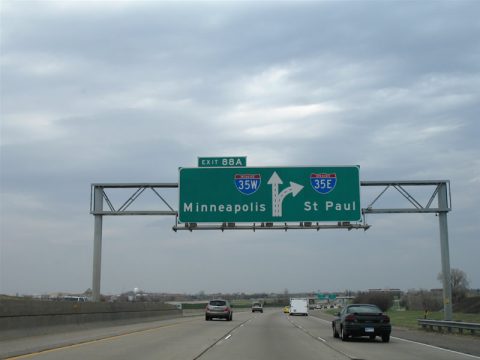
The Twin Cities are one of two areas in the country to retain suffixed Interstate highways (Dallas-Fort Worth being the other). Interstate 35 splits into Interstate 35W through Minneapolis and Interstate 35E through St. Paul.
Interstate 35E retains Interstate 35’s mile based exit numbers, while Interstate 35W’s mileage starts at zero (this is similar to Dallas Fort-Worth’s as well). Although AASHTO mandated that all suffixed Interstate numbers be changed to remove the alpha character, both the Twin Cities and DFW could not compromise as to which would get Interstate 35 and which would get a I-x35. Thus two sets of Interstate 35E and 35W remain.
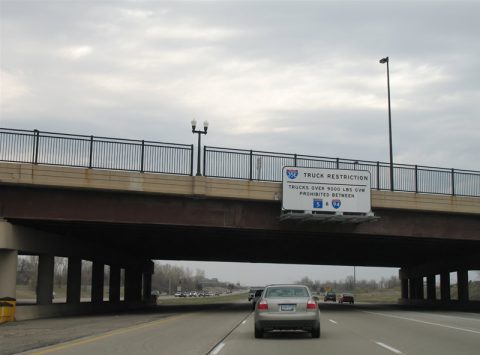
Interstate 35E through St. Paul is unusual in that it includes a truck restriction for vehicles over 9,000 lbs and has a speed limit set at just 45 mph.
For years residents south of downtown St. Paul fought the coming of Interstate 35E and the compromise struck for its construction entailed a number of facets. The freeway built will blend into its settings in a parkway like format, be restricted from heavy truck traffic between Minnesota 5 and Interstate 94, and have a mandated 45-mph speed limit. Trucks entering the Twin Cities via Interstate 35E are alerted to use Interstate 494 around the restricted section of Interstate 35E. Thanks to Charles Abel for the background on this; for more see Adam Froehlig’s I-35E South Metro (inside the Beltway)
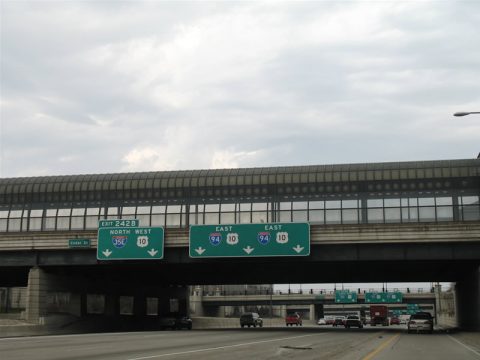
Once in downtown St. Paul, Interstate 35E merges briefly with Interstate 94 north of the central business district. A depressed freeway carries the two highways a half mile or so, allowing a short amount of time for drivers to make their lane changes for the forthcoming split.
U.S. 10 tags along via Interstate 35E north of Interstate 94, and Interstate 94 east of Interstate 35E. U.S. 52 is also here in silent fashion, following Interstate 94 from a point nearby all the way to the North Dakota state line.
Minneapolis has more substandard interchanges and bad weave situations between two freeways than any other metropolitan area I have witnessed in my opinion. One such problem spot is the touch and go merge between Interstate 35W and the Crosstown (Minnesota 62). Minnesota 62, locally known as the Crosstown Highway, serves the south suburbs, Minneapolis-St. Paul International Airport, and southern reaches of Minneapolis. Interstate 35W of course is the main north-south artery between downtown and Richfield, Bloomington, and other south side suburbs.
Interstate 35W and Minnesota 62 join for three quarters of a mile along the Minneapolis and Richfield city lines. Travelers must negotiate a tight series of ramp merges, some on the left, complicated with heavy traffic during peak hours. On the westbound Crosstown for instance, drivers are relegated to one through lane at the merge with Interstate 35W and then must move over two lanes to the right to continue on Minnesota 62 west to Edina.
To address these issues, Mn/DOT will reconstruction the junction and eliminate the short weave between the two freeways. Crosstown travelers will travel along a new set of roadways parallel to the Interstate 35W mainline, with new ramps joining the two. New carriageways will be built on the outside of the existing Interstate 35W & Minnesota 62 lanes and the Interstate 35W mainline expands to six overall lanes with two HOV-dedicated lanes. Mn/DOT plans to award a $282-million construction contract in June. Project web site: http://www.dot.state.mn.us/projects/crosstown/
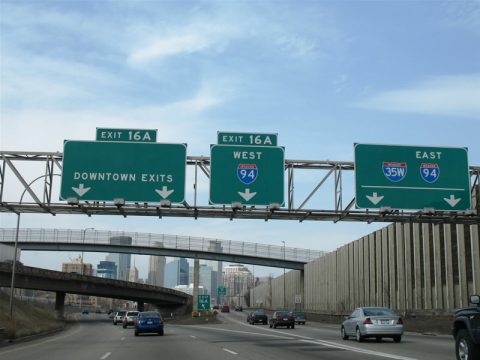
Approaching downtown Minneapolis on Interstate 35W from the south. Interstate 35W, like Interstate 35E, shares a brief overlap with Interstate 94 in downtown.
The two share 0.8-miles of freeway. Exit 16A provides a direct route into downtown via unsigned Minnesota 65, a short freeway spur between Interstates 35W & 94 and the 4th & 5th Avenue couplet at 10th Street. Minnesota 65 represents the former alignment of U.S. 65 through the Twin Cities. The state highway portion used to travel wholly from Interstate 35W northward through downtown to the Mississippi River bridge and Central Avenue. In 2005 a section of Minnesota 65, between 10th Street and 3rd & /Washington Avenues in downtown Minneapolis, was decommissioned. That leaves two segments of Minnesota 65: the signed portion from Washington Avenue northward and the unsigned freeway spur from Interstate 35W & 94.
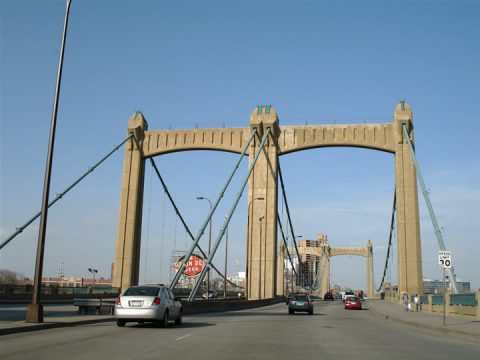
Spanning the Mississippi River is the Hennepin Avenue concrete suspension bridge. Built in 1990, the six-lane span carries Hennepin Avenue northeast from downtown Minneapolis to Main Street along the east banks of the Mississippi.
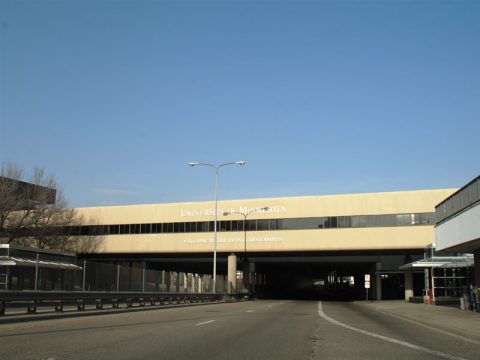
An unusual roadway in the downtown Minneapolis area is Washington Avenue leading east through the University of Minnesota campus. The four-lane avenue travels underneath part of the University of Minnesota campus, including the West Bank Skyway. Aerials display what appears to be a covered walkway above the Washington Avenue Bridge as it spans the Mississippi River.

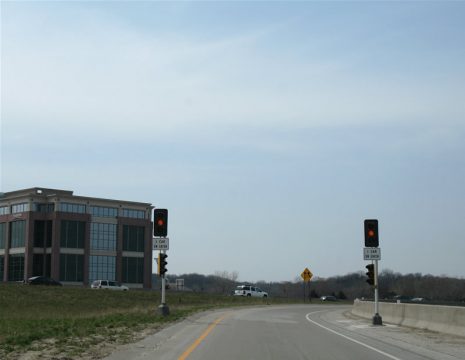
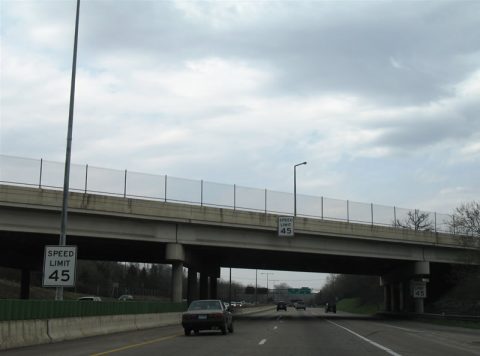
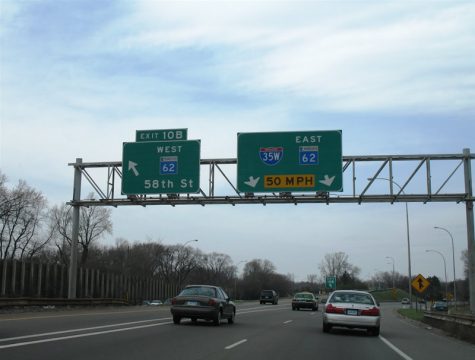
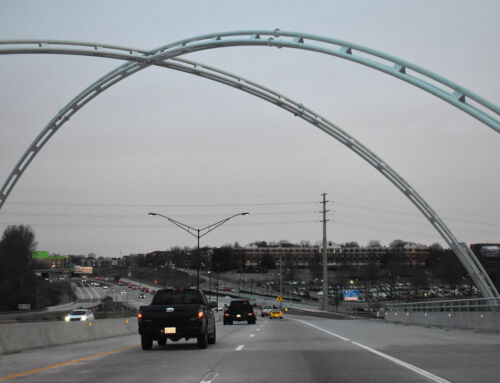

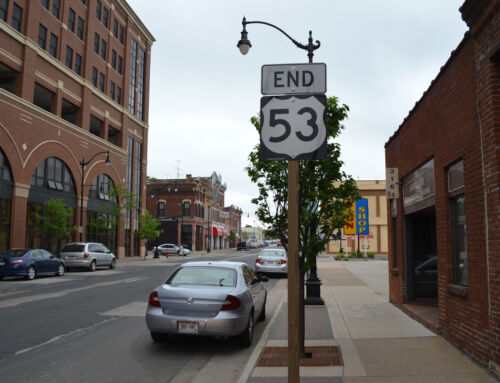
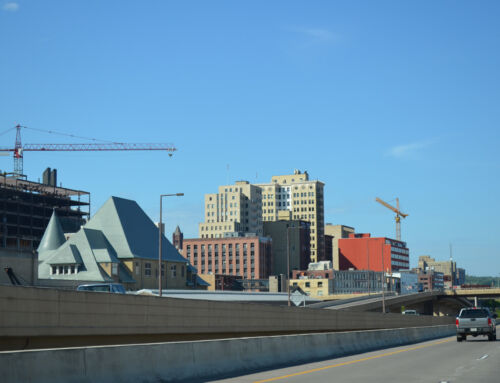
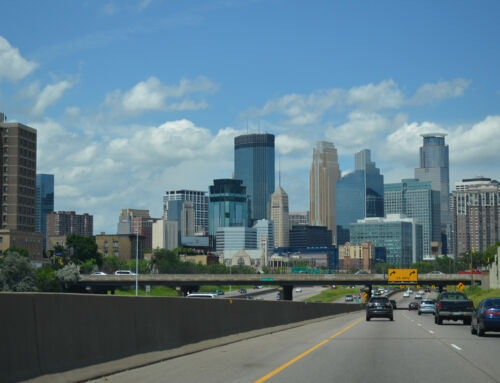
“One issue that I have with the Minneapolis area ramp meters is that they include freeway to freeway connections, such as the one pictured here along the ramp from Minnesota 100 south onto Interstate 494 west. So in a sense a high-speed connection becomes an off-ramp with a stoplight.”
One freeway-to-freeway ramp that could use a meter is the one that comes from both directions on DE 141, and goes to I-95 north (and eventually I-495 north.) Currently, traffic coming from DE 141 southbound has to yield to the traffic coming from DE 141 northbound (and carrying US 202 northbound). Most of the time it’s not that big a deal, but at rush hour that ramp’s traffic backs up onto the 141 mainline, choking off one of the two through lanes.
Phoenix is another city that has ramp metering. While it is not present in some areas, it is frequently used out there. I think they don’t really help traffic as a whole, but make it worse, especially on the streets getting on to the freeways. It just slows it down I think.
The Milwaukee Metro area is also home to metered ramps, however I have not seen them on freeway-to-freeway junctions. I’ll keep my eyes open for them.
Also, I definitely agree with your comment on the merging issues. There are also so many cloverleafs at busy interchanges which just make it that much worse in Minneapolis/St. Paul.
One last thing: Technically I-35W and I-94 do not merge. They remain on separate carriageways similar to the Mixmaster Interchange in downtown Dallas between I-35E and I-30. I believe that sign bridge has that sign there to show the connection to eastbound I-94 is further up than the one to westbound I-94 on I-35W north.
…well better late than never for the Commons. This was supposed to start a few years ago but this was put off when I-494 work in the southwest metro began. Then last year the state didn’t have the funds so they wanted the contractors to pay some of the initial costs until the state could get the money to pay them back, and no contractors bid on it because of that.
Basically, all the real bad interchanges are going off the board (except for the I-694/US 10/MN 51 mess in Arden Hills and the Spaghetti Junction downtown) since the I-35E/694 project is underway and should finish next year. In addition, studies are underway to modify some of the worst cloverleaf interchanges, but we’re still going to have enough to make people think we’re Ireland.
Chris is correct. I-35W and I-94 do not share pavement…though they share a common right-of-way. And the ramp from NB 35W to EB 94 is indeed further up the freeway.
Milwaukee does have freeway to freeway metered ramps. They are at the Stadium interchange coming from U.S. 41 and Miller Park Way to both directions of I-94.